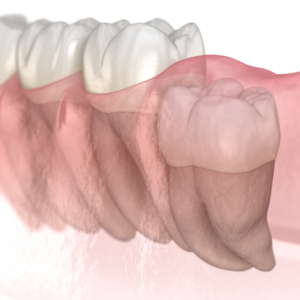Wisdom teeth surgery is a common dental procedure that involves the surgical removal of the third molars, which are located at the back of the mouth and usually emerge during late adolescence or early adulthood. Here’s an overview of the wisdom teeth surgery process:
- Consultation and Examination: The process typically begins with a consultation and examination by an oral surgeon or a dentist who specializes in oral surgery. The dentist will assess the position, condition, and potential complications associated with the wisdom teeth, and determine if extraction is necessary.
- X-Rays and Imaging: X-rays or other imaging techniques, such as panoramic or cone-beam computed tomography (CBCT) scans, may be taken to get a clear picture of the position and orientation of the wisdom teeth, as well as their relationship to the surrounding structures, such as nerves, roots of adjacent teeth, and sinuses.
- Anaesthesia or Sedation: Wisdom teeth surgery can be performed under local anaesthesia, where only the immediate area around the tooth is numbed, or under general anaesthesia, where the patient is unconscious and completely unaware during the procedure. The type of anaesthesia used will depend on the complexity of the extraction and the patient’s preference and medical history.
- Extraction: Once the patient is adequately numbed or sedated, the oral surgeon or dentist will proceed with the extraction. The surgeon may need to make an incision in the gum tissue to access the tooth, and may need to remove bone or divide the tooth into smaller pieces for easier extraction. The tooth may be extracted in its entirety or in sections, depending on its position and condition.
- Stitching and Gauze Placement: After the extraction, the surgeon may place stitches (sutures) to close the incision and promote healing. Gauze may also be placed over the extraction site to control bleeding and facilitate blood clot formation.
- Postoperative Care: The patient will be given instructions for postoperative care, which may include guidelines on pain management, swelling reduction, oral hygiene, diet, and activity restrictions. It’s important to follow these instructions carefully to promote proper healing and reduce the risk of complications.
- Follow-Up Appointments: The patient will occasionally need to schedule follow-up appointments with the treating clinician to monitor healing and ensure that there are no complications.
Recovery from wisdom teeth surgery may vary depending on the complexity of the extraction, but most patients experience some swelling, bruising, pain, and limited mouth opening for a few days after the procedure. Your dentist will walk you though the process, and give you a guide to what to expect for your individual wisdom tooth removal.

